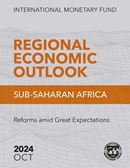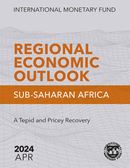Regional Economic Outlook
Sort by: Date Region
Sub-Saharan Africa
Regional Economic Outlook for Sub-Saharan Africa, October 2024 | Reforms amid Great Expectations
October 25, 2024
Description:
Sub-Saharan African countries are implementing difficult and much needed reforms to restore macroeconomic stability, and while overall imbalances have started to narrow, the picture is varied. Policymakers face three main hurdles. First, regional growth, at a projected 3.6 percent in 2024, is generally subdued and uneven, although it is expected to recover modestly next year to 4.2 percent. Second, financing conditions continue to be tight. Third, the complex interplay of poverty, scarce opportunities, and weak governance--compounded by a higher cost of living and short-term hardships linked to macroeconomic adjustment--are fueling social frustration. Within this environment, policymakers face a difficult balancing act in striving for macroeconomic stability while also working to address development needs and ensure that reforms are socially and politically acceptable. Protecting the most vulnerable from the costs of adjustment and realizing reforms that create sufficient jobs will be critical to mobilize public support.
Regional Economic Outlook for Sub-Saharan Africa, April 2024 | A Tepid and Pricey Recovery
April 19, 2024
Description:
After four turbulent years, the outlook for sub-Saharan Africa is gradually improving. Growth will rise from 3.4 percent in 2023 to 3.8 percent in 2024, with nearly two thirds of countries anticipating higher growth. Economic recovery is expected to continue beyond this year, with growth projections reaching 4.0 percent in 2025. Additionally, inflation has almost halved, public debt ratios have broadly stabilized, and several countries have recently issued Eurobonds, ending a two-year hiatus from international markets. However, not all is favorable and risks to the outlook remain tilted to the downside. The funding squeeze persists as the region’s governments continue to grapple with financing shortages, high borrowing costs, and impending debt repayments. Amid the challenges, sub-Saharan African countries will need additional support from the international community to develop a more inclusive, sustainable, and prosperous future.
Regional Economic Outlook for Sub-Saharan Africa, October 2023
October 10, 2023
Description:
LIGHT ON THE HORIZON? Still emerging from the COVID-19 pandemic, countries in sub-Saharan Africa have been hit by a sluggish global economy, worldwide inflation, high borrowing costs, and a cost-of-living crisis. In many cases, inflation is still too high, borrowing costs are still elevated, exchange-rate pressures persist, and political instability is an ongoing concern. To ensure that the coming rebound is more than just a transitory glimpse of sunshine, it is important for authorities to guard against a premature relaxation of stabilization policies, while also focusing on reforms to both claw back lost ground from the four-year crisis and also to create new space to address the region’s pressing development needs.
Regional Economic Outlook for Sub-Saharan Africa, April 2023
April 14, 2023
Description: Growth in sub-Saharan Africa will decline to 3.6 percent this year. Amid a global slowdown, activity is expected to decelerate for a second year in a row. Still, this headline figure masks significant variation across the region. The funding squeeze will also impact the region’s longer-term outlook. A shortage of funding may force countries to reduce resources for critical development sectors like health, education, and infrastructure, weakening the region’s growth potential.
Regional Economic Outlook for Sub-Saharan Africa, October 2022
October 14, 2022
Description: Sub-Saharan Africa’s recovery has been abruptly interrupted. Last year, activity finally bounced back, lifting GDP growth in 2021 to 4.7 percent. But growth in 2022 is expected to slow sharply by more than 1 percentage point to 3.6 percent, as a worldwide slowdown, tighter global financial conditions, and a dramatic pickup in global inflation spill into a region already wearied by an ongoing series of shocks.
Regional Economic Outlook for Sub-Saharan Africa, April 2022
April 28, 2022
Description: The economic recovery in sub-Saharan Africa surprised on the upside in the second half of 2021, prompting a significant upward revision in last year’s estimated growth, from 3.7 to 4.5 percent. This year, however, that progress has been jeopardized by the Russian invasion of Ukraine which has triggered a global economic shock that is hitting the region at a time when countries’ policy space to respond to it is minimal to nonexistent. Most notably, surging oil and food prices are straining the external and fiscal balances of commodity-importing countries and have increased food security concerns in the region.
Regional Economic Outlook for Sub-Saharan Africa, October 2021
October 21, 2021
Description: The world remains in the grip of the COVID-19 pandemic and a seemingly accelerating pace of climate change, both of which underscore the need for increased global cooperation and dialogue. Solutions to these global problems must involve all countries and all regions, especially sub-Saharan Africa, with the world’s least vaccinated population, most promising renewable energy potential, and critical ecosystems. Sub-Saharan Africa’s economy is set to expand by 3.7 percent in 2021 and 3.8 percent in 2022. This follows the sharp contraction in 2020 and is much welcome, but still represents the slowest recovery relative to other regions.
Regional Economic Outlook for Sub-Saharan Africa, April 2021
April 15, 2021
Description: Despite turning out better than expected, growth in 2020 is estimated to be the worst on record, at –1.9 percent, leading to a large increase in poverty. In 2021, the region’s economy is expected to resume expansion at 3.4 percent, weaker than the 6 percent for the rest of the world, amid a continued lack of access to vaccines and limited policy space to support the crisis response and recovery. Macroeconomic policies will in many countries entail some difficult choices. Saving lives remains the first priority, which will require access to affordable vaccines, ensuring that the logistical and administrative prerequisites of a vaccination rollout are in place, targeted containment efforts, and added spending to strengthen local health systems. The next priority is to unlock the region’s potential by creating more fiscal space and implementing transformative reforms. These include mobilizing domestic revenue, strengthening social protection, promoting digitalization, and improving transparency and governance. Countries will also have to consolidate their fiscal positions to bring debt back on a sustainable footing. Such measures will help lift longer-term growth and provide opportunities for the region’s new job seekers. The international community has a key role to play by ensuring more equitable and quicker access to vaccines and other medical products; and by providing low-income countries the external funding needed to pursue the policy priorities sketched above and avoid long-term scarring.
Regional Economic Outlook for Sub-Saharan Africa
October 22, 2020
Description: Sub-Saharan Africa is contending with an unprecedented health and economic crisis— one that, in just a few months, has jeopardized years of hard-won development gains and upended the lives and livelihoods of millions. The current outlook for 2020–21 is broadly unchanged from the June update, with activity in 2020 projected to contract by 3.0 percent, still the worst outcome on record. For 2021, regional growth should recover modestly to 3.1 percent.
Sub-Saharan Africa Regional Economic Outlook: A Cautious Reopening
June 29, 2020
Description: The outlook for 2020 for sub-Saharan Africa is considerably worse than was anticipated in April and subject to much uncertainty. Economic activity this year is now projected to contract by some 3.2 percent, reflecting a weaker external environment and measures to contain the COVID-19 outbreak. Growth is projected to recover to 3.4 percent in 2021 subject to the continued gradual easing of restrictions that has started in recent weeks and, importantly, if the region avoids the same epidemic dynamics that have played out elsewhere. Africa’s authorities have acted swiftly to support the economy, but these efforts have been constrained by falling revenues and limited fiscal space. Regional policies should remain focused on safeguarding public health, supporting people and businesses hardest hit by the crisis, and facilitating the recovery.The region cannot tackle these challenges alone, and a coordinated effort by all development partners will be key.





